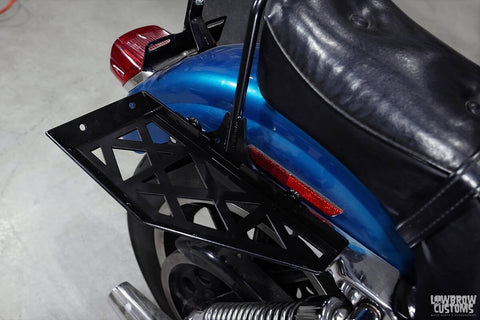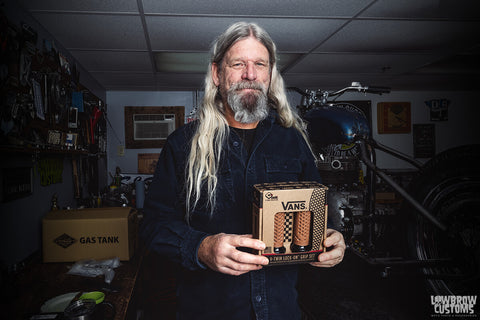Winter Motorcycle Workshop Part 1 - Installing the Insulation
I wrote this up and took photos last fall of 2008 as I worked on finishing off a single car garage bay here at my shop to be used for working on bikes in the frigid winters here in Ohio. I hope this is of use to those of you who are trying to work in garages so cold your feet turn into blocks of ice and you can't close your hands, I empathize. With a bit of money for the materials and some labor, and perhaps some help from a friend, you can quickly insulate your shop and make it a much more comfortable work space.
I am working on transforming an unused bay in my shop into my winter workshop, as my main garage isn't heated and has big non-insulated bay doors on both sides and would be tough to insulate properly. I figured it might be helpful to someone to post some photos of the work I am doing to get it ready for winter.
Here is the bay in question, approx. 8' x 19', with a bay door at one end and a man door at the other. It is sandwiched by insulated, heated bays which are my office and shop.
Step 1: Insulating the cheap steel 7' garage door
The first step was insulating the cheap steel 7' garage door. I used 1.5" thick sheets of rigid foam insulation, it has an R7 rating. Cut it to size and fit it into the panels pretty easily.
Step 2: Using a roll of vapor barrie cover the flammable pink foam
Next, I used a roll of vapor barrier, a 2' x 20' roll was around $20, it is 5/16" bubble wrap with aluminum coating on both sides, it cost about $20. It has an R3 rating and will help cover the pink foam, which is flammable. I cut that and tucked it in where possible, and where there wasn't a lip to tuck it into I used foil tape to secure it, found by the duct work at your local hardware store.
A bit of weatherstripping between the door panels and edges and it is 100x better than it was, and for a total cost of around $65.
Step 3: Insulating and finishing the ceiling
Next I will be insulating and finishing the ceiling, installing more lights, putting a stud wall on the exterior wall by the man door, running 220 for my welder, running black pipe and installing natural gas wall heater, building a work bench, etc etc. I will have a bike lift in here as well. It will be a bit crowded but nice and toasty, no more wrenching in a 0 degree garage.
Cased around the doors, these are interior doors leading into my shop.
Resized the attic access and put drop down stairs, great storage for my hoarding of motorcycle parts. The stud wall is in on the one exterior wall.
Picked up the insulation for the ceiling, as well as baffles. Baffles are available in plastic or styrofoam, either is fine. These get stapled to the inside of the roof, slide them down til they just about butt up to the gables (the underneath overhang of the roof). They allow for air to keep flowing up into the attic to ventilate, if you stuffed insulation all the way to the gables it would block air flow and the insulation could get wet. They are available in 16" or 24" widths depending on the centers of your joists.
Installing the insulation is easy, just stick it up there and staple the flaps of the vapor barrier (brown kraft paper) to the ceiling joists. OR even easier if you aren't going to have finished attic space above (ie a floor) you can just put up whatever you are using for your ceiling (wood, drywall), leaving an access panel, then go up there and simply roll the insulation out, or fill it with loose fill insulation.
The insulation should just extend onto the top of the exterior walls, don't cram it into the gables. A tip, douse yourself with baby powder before installing the insulation, it keeps the fibers from sticking to your sweat.
Trickiest part was making the garage door supports look clean, it turned out real nice.
Winter Motorcycle Workshop Part 2 - Installing the Insulation Bay

My goal was to create a well insulated bay so I could work in nice warm comfort while it was 0 degrees and below outside. Went through about 8 or 9 tubes of caulk hitting every nook and cranny, spray foam, trim, caulk and smooth the seams before painting for a finished look and to get rid of drafts. Small natural gas wall heater is in, this bay is only about 200 sq ft, this heater is good for 400 sq ft heats up the bay in 5 minutes
Step 1: Cutting a spot in the center of the floor and dig out 4' deep
Got a sweet lift for the bay from craigslist, air over oil hydraulic lift. Need to saw cut a spot in the center of the floor and dig out 4' deep, this sets down in there and has a flange that fits over the floor, so it is almost totally flush. Going to saw cut a channel to the wall and bury a hard line and put the air controls on the wall.
Was going to go with a harbor freight lift, this is so much nicer and actually a bit cheaper. Access to all parts of the bike, the ram lifts up to 1000 lb 3' in the air. (NOTE: in retrospect this lift is really neat, but was such a pain to install that I could have easily gone with the normal style table lift and been just fine)
Greg and I ran air from my garage through the attic of my Lowbrow Customs shop and into the attic of my new work bay. I had an air reel I was going to mount on the ceiling but Greg had a better idea and we ended up with a nice flush mounted air reel.
Step 2: Using a hole saw to cut a nice circle and feed the hose back through it
The piece of flooring will go back in in the attic, I used a hole saw to cut a nice circle and feed the hose back through it. It works perfect, butted the flange on the 4-wheel guide up to a floor joist and screwed it to it.
The hydraulic lift was a bigger pain in the ass than anticipated. The hole included cutting out drain tile and re routing drain spouts, jackhammering a big rock that ended up not being so big, and tons of ground water in my very moist land. Wrapped up the lift nice and watertight so it can sit in ground water if necessary. Coroplast (corrugated plastic, sign substrate), shrink wrap, heavy duty garbage bag, shrink wrap. And what do you know, the lift actually works!
Finished welding up the support for my new workbench last night, here is part of it. 1.5" x 1.5" x .125" angle, the top will be about 2'x 4', I have a slab of 1.25" wood then 1/8" steel plate to top it off.
Floor sealed, airlines run, little crap to finish up and I am ready to start wrenching in here!
Final Notes: My shop has been done about 8 or 9 months now, and I work in there regularly on my bikes. It is really nice having all my tools on pegboard instead of all over the garage, and there is enough room to have a bike on the lift and another off to the side in progress without being in the way.
It becomes a mess when I am doing grinding and fabrication work though, it would be ideal to use this as a motor building / assembly bay and have another area for doing grinding, drilling etc. There was a decent amount of work to finish this bay off, but as it is getting colder out now it is nice that I just turn on the heater and keep working in comfort.
Related Products

















